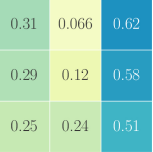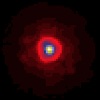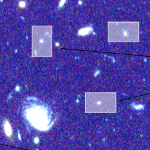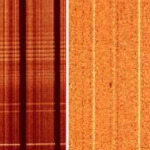| | |
|
|

|
|
At blue wavelengths, MOSAIC will be able to get a spectrum of a V = 25 mag galaxy with S/N ~ 5 (resolution R=5000) in a ~ 4 hour exposure with the HMM-VIS mode. |
| |
| | |
Simulations
Detailed simulations have been performed to assess the performance of the blue part of the visible spectrograph. To this end, we used the WEBSIM-COMPASS simulator. Our study aimed to understand the behavior of noise, the effects of sky variability, and the scaling between signal-to-noise (S/N) and several other observational (exposure time) and instrumental (resolution R, throughput T%) characteristics. Briefly, an astrophysical target was modeled as a high-resolution data cube, which was subsequently convolved with the point-spread function (PSF) that represented the optical path through the atmosphere and the telescope, including the adaptive optics system. Realistic sky background, photon noise, and detector noise were added. The simulator produced a data cube which we analyzed as if it were real data.
Read more: Performance of MOSAIC in the blue
 A broad range of science cases for multi-object spectroscopy on the ELT demand better angular resolution than typically obtained from astronomical seeing, requiring the use of adaptive optics (AO) over fields of view of several arcminutes on the sky.
A broad range of science cases for multi-object spectroscopy on the ELT demand better angular resolution than typically obtained from astronomical seeing, requiring the use of adaptive optics (AO) over fields of view of several arcminutes on the sky.

 The detection of the expected sources of the reionization of the Universe is one of the prominent MOSAIC science case. We simulated the detection of UV interstellar lines at z = 7 and the detection of the Ly-alpha line and the Lyman break at z = 9, both with MOAO-assisted IFUs and GLAO-fed fibers. The simulations show that the most constraining case is the detection of UV interstellar lines. The optimal pixel size is found to be ~80 mas, which allows detecting UV lines up to JAB ~ 27 in 40 hours of integration time. Lyman Alpha Emitters and Lyman Break Galaxies are detected respectively up to JAB ~ 29-30 and JAB ~ 28 with an 80 mas/pixel IFU and within only 10 hours of integration time. Detection limits are typically ~ 0.5-1 mag fainter using MOAO-fed IFUs than using GLAO-fed fibers, but the multiplex is one magnitude larger in the mode using GLAO-fed fibers. Further details can be found in Disseau et al. (2014).
The detection of the expected sources of the reionization of the Universe is one of the prominent MOSAIC science case. We simulated the detection of UV interstellar lines at z = 7 and the detection of the Ly-alpha line and the Lyman break at z = 9, both with MOAO-assisted IFUs and GLAO-fed fibers. The simulations show that the most constraining case is the detection of UV interstellar lines. The optimal pixel size is found to be ~80 mas, which allows detecting UV lines up to JAB ~ 27 in 40 hours of integration time. Lyman Alpha Emitters and Lyman Break Galaxies are detected respectively up to JAB ~ 29-30 and JAB ~ 28 with an 80 mas/pixel IFU and within only 10 hours of integration time. Detection limits are typically ~ 0.5-1 mag fainter using MOAO-fed IFUs than using GLAO-fed fibers, but the multiplex is one magnitude larger in the mode using GLAO-fed fibers. Further details can be found in Disseau et al. (2014). The ELT will be the first telescope that entirely depends for routine operations on adaptive optics (AO). In parallel to the telescope Phase B design study, initial instrument Phase A conceptual studies were conducted in 2007-2010. Given the complexity of the telescope and instruments designs, it was also realized that huge parameter spaces had to be explored before educated design choices could be made. To assess the impact of any particular design trade-off directly from the scientific analysis of the expected observations, end-to-end instrument simulation tools that mimic realistic data were required.
The ELT will be the first telescope that entirely depends for routine operations on adaptive optics (AO). In parallel to the telescope Phase B design study, initial instrument Phase A conceptual studies were conducted in 2007-2010. Given the complexity of the telescope and instruments designs, it was also realized that huge parameter spaces had to be explored before educated design choices could be made. To assess the impact of any particular design trade-off directly from the scientific analysis of the expected observations, end-to-end instrument simulation tools that mimic realistic data were required. Fiber-fed spectrographs can now have throughputs equivalent to slit spectrographs. However, the sky subtraction accuracy that can be reached on such instruments has often been pinpointed as one of their major issues, in relation to difficulties in scattered light and flat-field corrections or throughput losses associated with fibers. Using technical time observations with FLAMES-GIRAFFE, two observing techniques, namely dual staring and cross beam switching modes, were tested and the resulting sky subtraction accuracy reached in both cases was quantified. Results indicate that an accuracy of 0.6% on the sky subtraction can be reached, provided that the cross beam switching mode is used. This is very encouraging regarding the detection of very faint sources with future fiber-fed spectrographs such as VLT/MOONS or ELT/MOSAIC.
Fiber-fed spectrographs can now have throughputs equivalent to slit spectrographs. However, the sky subtraction accuracy that can be reached on such instruments has often been pinpointed as one of their major issues, in relation to difficulties in scattered light and flat-field corrections or throughput losses associated with fibers. Using technical time observations with FLAMES-GIRAFFE, two observing techniques, namely dual staring and cross beam switching modes, were tested and the resulting sky subtraction accuracy reached in both cases was quantified. Results indicate that an accuracy of 0.6% on the sky subtraction can be reached, provided that the cross beam switching mode is used. This is very encouraging regarding the detection of very faint sources with future fiber-fed spectrographs such as VLT/MOONS or ELT/MOSAIC.